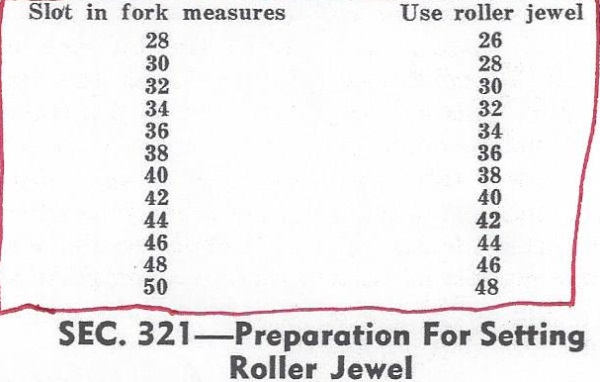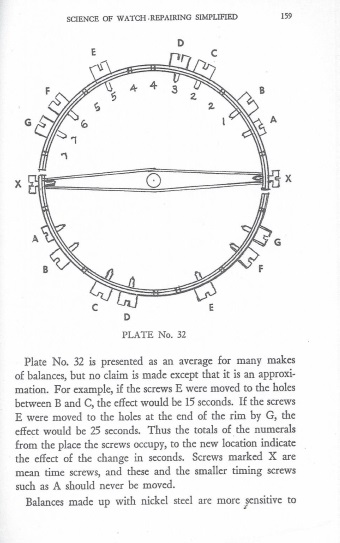
| WWT Shows | CLICK TO: Join and Support Internet Horology Club 185™ | IHC185™ Forums |

|
• Check Out Our... • • TWO Book Offer! • |
Welcome Aboard IHC185™  Internet Horology Club 185
Internet Horology Club 185  IHC185™ Discussion Site Main Page
IHC185™ Discussion Site Main Page  Technical, Shop Talk and Internet Links
Technical, Shop Talk and Internet Links  Watch Repair Questions and Answers
Watch Repair Questions and Answers  TRIVIA: Sets of Questions. More added. 03.26.14
TRIVIA: Sets of Questions. More added. 03.26.14
 Internet Horology Club 185
Internet Horology Club 185  IHC185™ Discussion Site Main Page
IHC185™ Discussion Site Main Page  Technical, Shop Talk and Internet Links
Technical, Shop Talk and Internet Links  Watch Repair Questions and Answers
Watch Repair Questions and Answers  TRIVIA: Sets of Questions. More added. 03.26.14
TRIVIA: Sets of Questions. More added. 03.26.14Go  | New Topic  | Find-Or-Search  | Notify  | Tools  | Reply to Post  |  |
| IHC Life Member |
I Just decided to have a little educational fun. Some trivia questions with the answers under the last question in this forum. This is from the Chicago School of Horology. Don't cheat yourself, think about you knowledge of the subject. ================================================== 1. Is it necessary to oil the stem on a pocket watch case and, if so at what point? 2. What is the name used to describe the set of gears that transmit power? 3. What controls the time piece through the regularity of it's oscillations? 4. What is the purpose of the clutch lever? 5. Name the jewels that do not act as bearing surfaces. (3) 6. What is the advantage of an olive hole jewel? Let me know if you would like more of this trivia. Answers are below. 1.Yes, at the point of contact but sparingly. 2. Train. 3. Balance assembly. 4. To move from winding to setting. 5. Entrance jewel, exit jewel and roller jewel. 6. It has a smaller bearing surface. | ||
|
Keep them coming Patrick | ||||
|
| IHC Life Member |
Mike, OK I'll run through the entire list of several, in the books I have. | |||
|
| IHC Member 1541 |
Great idea Patrick, I'm looking forward to more. | |||
|
| IHC Life Member |
2nd trivia. 7. How many revolutions does the center wheel make in a hour? 8. How many revolutions does the fourth wheel make in an hour? 9. How many should a watch run on 1 winding? 10. Is metric or Dennison more accurate for measuring a mainspring? 11. How much of the MS barrel should be occupied by a main spring with 11 coils? 12. How much of the MS barrel should be occupied by a main spring with 13 coils? 13. Will a watch of 7 jewels require the same size main spring as one with 11 jewels? 14. What is the advantage of an olive hole jewel? 15. How do you recognize a Waltham balance staff? (Friction staff) 16. What does the term genuine watch material mean? 7. One.. 8. Sixty. 9. 32-36 average. 10. Metric. 11. 1/2. 12. 1/2 13. No. 14. It has a smaller bearing surface. 15. By the blued hub on the balance wheel. 16. OEM = Original equipment manufacture. (Factory made) | |||
|
| IHC Member 1650 |
Isn't 15 only true for Waltham friction staffs? | |||
|
| IHC Life Member |
Doug, You caught me! It should be Waltham friction staff, not just balance staff. | |||
|
| Administrative Assistant |
Here is another set of questions that Patrick posted... _________________________________ Trivia questions, set 2 posted February 28, 2014 12:54 A=22 A. Name the jewels in a 17 jewel watch that are not used as a bearing surface? B. What is the advantage of an olive hole jewel? C. The main purpose of truing & poising is? D. The balance screws are placed at the factory for? E. In poising add or subtract weight if the regulator is as fast as it will go? F. Is it practical to do watch repair without a lathe? G. What does ISOCHRONISM mean? H. How much space should a Mainspring occupy in the barrel? I. What is a cross curve mainspring? J. Do you oil a cannon pinion? K. When is an escapement over-banked or out of action? The End ANSWERS A. R. stone, L. stone, (Receiving stones) roller jewel. B. It has a smaller bearing surface. C. So the unit can be brought to time with the regulator. D. Temperature adjustment. E. More weight is removed than added. F. Although not required it's hard to get by without one. G. The equality of time. H. One half. I. One with a concave surface. J. Yes, sparingly. K. When the roller jewel jumps the slot. _________________________________ Please keep the Trivia questions coming in this topic. It helps anyone doing reference to go directly to the topic rather than trying to connect disjointed topics. Thank you for your cooperation, Debbie | |||
|
| IHC Life Member |
Debbie, Thanks for all your hard work. We do appreciate it. | |||
|
| IHC Life Member |
Set 4 of 4. 1. The regulator pins can by loose, just as long as they are there. 2. The balance pivots don't really matter if they are a little rough. The jewel will make them work? 3. Its OK if the roller jewel moves a little, just as long as it stays in place. 4. The endstone is to stop up down movement of the pivot or to retain the oil? 5. The Pallet stones are not really a critical component they can be chipped and should be a little loose. 6. You should reset the banking pins on every COA? 7. If you let a train unload quickly until it comes to a sudden stop, it's easier to get the Mainspring out. 8. The balance spring can touch the arm of the balance wheel and should be well oiled. 9. To remove a set of hands just pry up on them with the tool of you choice? 10. Poising means to add or remove screws from the balance wheel? 1. Not so. They must be tight with no shake. 2. Pivots must be as clean and smooth as you can make them. 3. The roller jewel must be solid. The shellac should be replaced at each COA. 4. The end stone should never be ground on by the pivots. 5. The Pallets should by perfect and firmly cemented in. Both entrance and exit stone. 6. It is best to leave them alone. They are factory set. 7. Never unload a train quickly. It can bend things you don't want bent. (I use the method of most books and push on the unload pin in the side of the watch or trip the lever that keeps the gear from unwinding. Further more I sometimes pull the pallet fork with my thumb on the main wheel and control it to full stop.) 8. The balance spring should never touch anything and should never have oil on it. 9. Never take the chance of ruining a dial, Always use a piece of wedged shaped paper under your pry tool. Hand removers work great. 10. Poising is wheel balancing done on a dedicated tool, and you should not try to adjust by adding or removing screws. You may add or remove washers. (I swap screws around or weigh and replace them but I have a .001 scale and have been doing it for a long time) | |||
|
| IHC Life Member |
If you find a mistake, correct it here on the forum so every body can see it. | |||
|
| IHC Life Member |
Here is a chart that tells you what size roller jewel to use with what size the fork is,  | |||
|
| IHC Life Member |
Do you know how to slow a watch by up to 10 minutes or how to speed it up when the regulator won't do it? First you should COA the unit and fix the problems but once in a while some one puts a balance wheel in it that is not correct for that watch. You can make it work properly buy the following method. Press CTRL & roll your mouse wheel to zoom in.  | |||
|
| Powered by Social Strata |
| Your request is being processed... |
|
Welcome Aboard IHC185™  Internet Horology Club 185
Internet Horology Club 185  IHC185™ Discussion Site Main Page
IHC185™ Discussion Site Main Page  Technical, Shop Talk and Internet Links
Technical, Shop Talk and Internet Links  Watch Repair Questions and Answers
Watch Repair Questions and Answers  TRIVIA: Sets of Questions. More added. 03.26.14
TRIVIA: Sets of Questions. More added. 03.26.14
 Internet Horology Club 185
Internet Horology Club 185  IHC185™ Discussion Site Main Page
IHC185™ Discussion Site Main Page  Technical, Shop Talk and Internet Links
Technical, Shop Talk and Internet Links  Watch Repair Questions and Answers
Watch Repair Questions and Answers  TRIVIA: Sets of Questions. More added. 03.26.14
TRIVIA: Sets of Questions. More added. 03.26.14©2002-2025 Internet Horology Club 185™ - Lindell V. Riddle President - All Rights Reserved Worldwide

